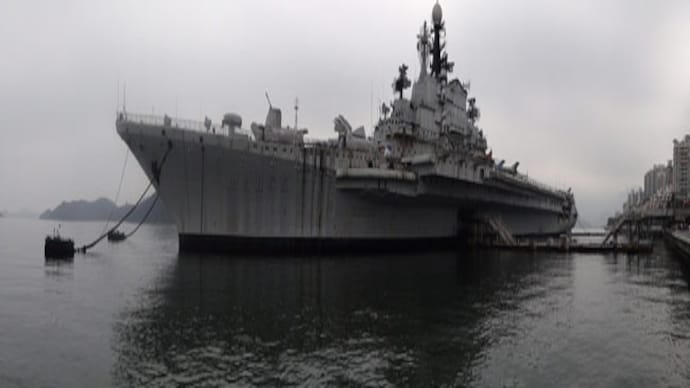INS Vikrant sale: Dragon's pride, elephant's burden
INS Vikrant has always hovered around the scrapyard ever since its 1997 decommissioning. Plans to convert the 18,000-tonne carrier into a maritime museum have somehow never taken off.


The Indian navy's first aircraft carrier the Vikrant was sold as scrap this month. The sale of the historic warship to a shipbreaker for Rs 63.2 crore comes after the failure of a 17-year-long struggle by the Maharashtra government to convert it into a floating museum for an estimated Rs 600 crore. Activists and defence correspondents in Mumbai have vowed to save it, yet again. The modest-sized light-fleet carrier epitomised the Indian navy for over 36 years. It performed a momentous, if symbolic role, of harrying the enemy in erstwhile East Pakistan during the 1971 war.
Yet, the Vikrant has always hovered around the scrapyard ever since its 1997 decommissioning. Plans to convert the 18,000-tonne carrier into a maritime museum have somehow never taken off.
In sharp contrast, China, a country that began operating an aircraft carrier in 2011, has not one but two aircraft carrier museums. The former Soviet aircraft carrier Kiev (sister ship of the Gorshkov acquired by the Indian navy last year) anchored in Tianjin, northern China and the Minsk, another Kiev class carrier, which forms the 'Minsk world', Asia's only military-themed park in Shenzen, north of Hong Kong. These 40,000-tonne carrier museums could well distinguish the different ways India and China perceive aircraft carriers. China, which began its naval modernization only two decades ago, sees its navy as an eventual global military rival to the powerful US navy. Aircraft carriers are powerful symbols of its naval aspirations. China purchased the hulk of the unfinished Soviet carrier 'Riga' over a decade ago and paintstakingly converted it into its first aircraft carrier the Liaoning, commissioned in 2012 as the Liaoning. China is believed to be secretly building two new carriers modeled on Soviet designs.
Chinese military thinkers scoured the globe for carrier knowhow. In the mid-1980s, they acquired the decommissioned aircraft carrier HMAS Melbourne, a sister ship of the Vikrant to study. It is likely China's booming economy also noticed the vast tourist potential of the five aircraft carrier museums operating in the US. In the early 1990s, China snapped up the two Kiev class carriers retired by the crumbling Soviet Union. The carriers now serve as tourist magnets on the Chinese coast. 'Minsk World' serves up an ersatz Soviet experience for its visitors complete with propaganda posters and Russian songs and dances. Chinese media reports say the Minsk attracted 33,000 visitors during the Chinese Lunar New Year week in 2006. The Kiev underwent a 9.6 million pound (Rs 86 crore) conversion into a floating sea-themed luxury hotel in Tianjin in 2011.
The Indian navy sees aircraft carriers as the centerpiece of its strategy to dominate a limited space, the Indian Ocean between the Malacca Straits and the Gulf of Aden. In addition to the Vikramaditya (ex-Gorshkov), it operates a 60-year old ex-British carrier the Viraat and is building an indigenous aircraft carrier 'Vikrant' in Kochi.
The navy rightly believes it has no job running decommissioned warships like the Vikrant (it has maintained the Vikrant since '97). However, crucial naval decisions taken by successive chiefs of the Mumbai-based Western Naval Command, have impeded the conversion of the carrier into a viable maritime museum. The navy has disallowed civilian helicopter flights from South Mumbai on the pretext that it impedes flights from its INS Shikra helicopter base in South Mumbai. This no-fly zone has swiftly killed plans to convert the Vikrant into a civilian heliport off the coast of South Mumbai. Surprisingly, the navy was open to the idea of helicopter operations in 2010 but inexplicably changed its stance. It will require intervention at the very highest levels to stop the warship from being towed to the short distance to the Darukhana scrapyard just north of the naval dockyard. It will require more than just intervention to realize the project.
